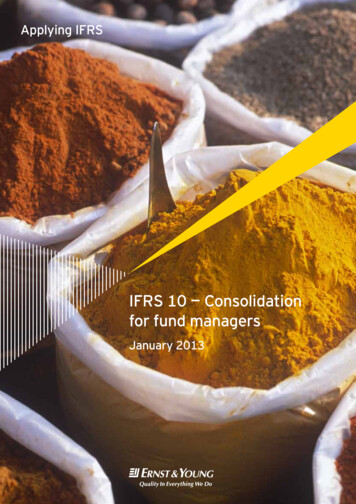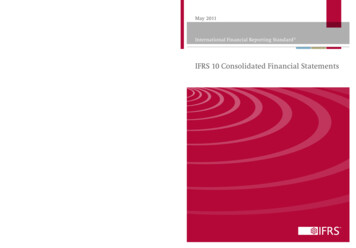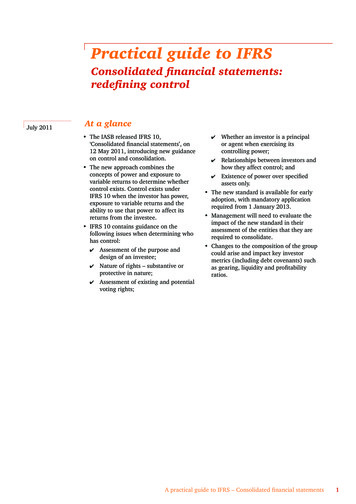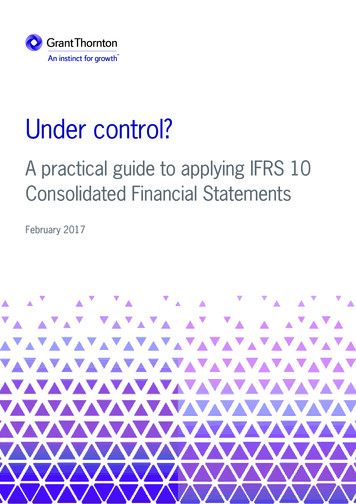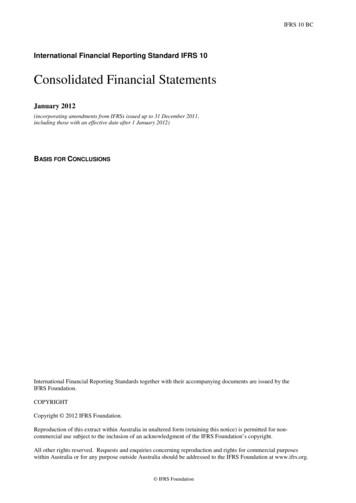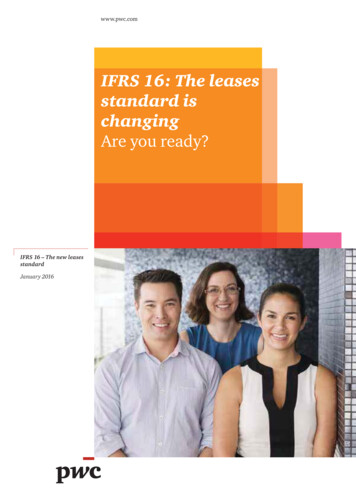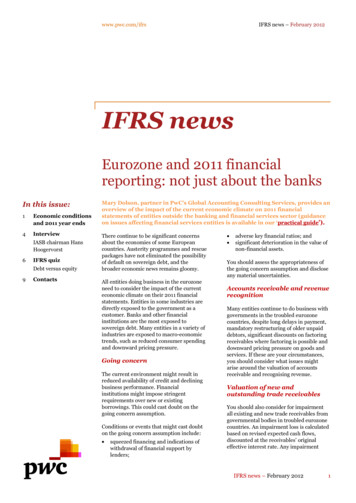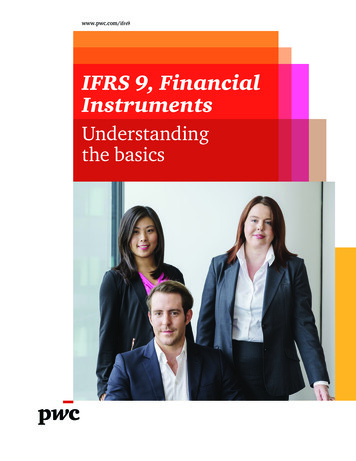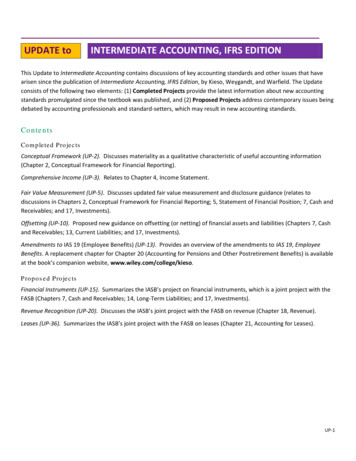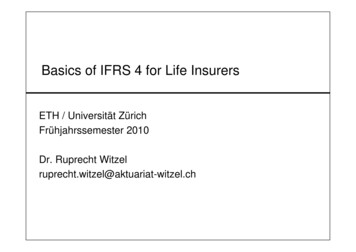
Transcription
Basics of IFRS 4 for Life InsurersETH / Universität ZürichFrühjahrssemester 2010Dr. Ruprecht Witzelruprecht.witzel@aktuariat-witzel.ch
Content1. Introduction2. Contract Classification3. Expense Classification4. BS and P&L Structure5. Asset Classification6. Technical Reserves7. Deferred Acquisition Costs8. Liability Adequacy Test9. Shadow Adjustments10. Legal Quote11. Purchase AccountingFinanz. Führungsinfo; Teil 4; IFRS 4Dr. Ruprecht Witzel; FS 102
Content12. Discretionary Participation Feature13. Embedded Derivatives14. Investment Contracts without DPF (IAS 39)Finanz. Führungsinfo; Teil 4; IFRS 4Dr. Ruprecht Witzel; FS 103
1. IntroductionThe implementation of the IFRS accounting standards forinsurers is planned in 2 phases: Phase I, in force since 2005, is documented in IFRS 4; itis only an interim solution with focus on disclosure In phase II, the planned final version of IFRS forinsurers with focus on valuation, the "Fair ValueConcept" should be introduced for all relevant BalanceSheet items The Fair Value Concept implies the valuation of allassets and liabilities of the Balance Sheet with marketvalues, if existing, or with "market-near" values (marketconsistent valuation; “marktnahe Werte”)Finanz. Führungsinfo; Teil 4; IFRS 4Dr. Ruprecht Witzel; FS 104
1. Introduction The introduction of phase II is nowadays planned for 2011;but probably it is not possible to fulfill the timetable Coordination is planned with– Solvency II (especially concerning the valuation of theliabilities) and– US GAAP This coordination takes time There are still some unsolved questions in determining fairvalues for traditional life insurance contracts with ex postpolicyholders’ participation (e.g. traditional endowments)Finanz. Führungsinfo; Teil 4; IFRS 4Dr. Ruprecht Witzel; FS 105
1. Introduction According to IFRS 4, three different classes of contracts are distinguished:– insurance contracts– investment contracts with DiscretionaryParticipation Feature (with DPF)– investment contracts without DPFIn insurance contracts there is significant insuranceriskIn investment contracts there is significant financialrisk, but no or no material insurance riskFinanz. Führungsinfo; Teil 4; IFRS 4Dr. Ruprecht Witzel; FS 106
1. Introduction If the policyholders' participation is at the discretion ofthe insurance company there is normally a DPF (fordetails on DPF see chapter 12) IFRS 4 is applied to:– insurance contracts issued– reinsurance contracts issued or held– investment contracts with a DPF IAS 39 is applied to investment contracts without DPFFinanz. Führungsinfo; Teil 4; IFRS 4Dr. Ruprecht Witzel; FS 107
1. Introduction Since IFRS 4 is "only" an interim solution IFRS 4 consists of general principles– There is some freedom to define the concreteaccounting policy according to IFRS 4One fundamental principle of IFRS 4 allows the insurerto change its accounting policy if, and only if, the newvaluation method is moving in the direction of marketvalues (market consistent valuation)– This is not only possible for a total insurance companyor group, but it is even allowed only for special subportfolios of a company (see § 22 - § 26 IFRS 4)Changes of the accounting policy should increase thereliability or relevance of the financial reportingFinanz. Führungsinfo; Teil 4; IFRS 4Dr. Ruprecht Witzel; FS 108
1. Introduction § 22 IFRS 4 reads as follows:– "An insurer may change its accounting policies forinsurance contracts if, and only if, the changemakes the financial statements more relevant to the economic decision-makingneeds of users and no less reliable, or more reliable and no less relevant to thoseneeds.– An insurer shall judge relevance and reliability bythe criteria in IAS 8."Finanz. Führungsinfo; Teil 4; IFRS 4Dr. Ruprecht Witzel; FS 109
1. Introduction Consequences of these principles are:– IFRS 4 does not aim at an uniform accountingpolicy– IFRS 4 does not provide detailed valuationrequirements (except for valuing invested assets)– IFRS 4 aims pushing the accounting policytowards fair value (market value)– IFRS 4 does allow to continue current accountingpolicy (“grandfathering”)– IFRS 4 introduces significant disclosurerequirementsFinanz. Führungsinfo; Teil 4; IFRS 4Dr. Ruprecht Witzel; FS 1010
1. Introduction Continuation of current accounting policy(“grandfathering”) includes– valuation of provisions (technical reserves)– valuation of insurance assets (e.g. DAC or PVFP)– valuation of insurance liabilities (e.g. URL)– income and outgo recognition (e.g. premiums andbenefits) Continuation of current accounting policy(“grandfathering”) does not include valuation ofinvested assets– For the valuation of invested assets there arespecific rules in IFRS 4 (see chapter 5)Finanz. Führungsinfo; Teil 4; IFRS 4Dr. Ruprecht Witzel; FS 1011
1. Introduction In IFRS 4 there are no prescribed IFRS-specific procedures for valuing– provisions (technical reserves)– insurance liabilities (e.g. URL according to USGAAP)– insurance assets (e.g. DAC) and– reinsurance contracts heldSo, there is some freedom in defining the accountingpolicy for these itemsBut, in IFRS 4 there are IFRS-specific rules how tovalue– invested assets (see chapter 5)Finanz. Führungsinfo; Teil 4; IFRS 4Dr. Ruprecht Witzel; FS 1012
1. Introduction In contrast to this, US GAAP consists of concrete rules for all items mentioned aboveThat is why the US GAAP rules are very often used ifIFRS 4 is silent on a topicThe concrete implementation of IFRS 4 is at thediscretion of the insurer and his external auditorThe so called "First Time Adapter" (FTA) should usethis freedom in a favorable manner– A FTA is an insurer who uses the accounting principlesof IFRS 4 for the first timeUS GAAP is judged as more market consistent thanlocal statutoryFinanz. Führungsinfo; Teil 4; IFRS 4Dr. Ruprecht Witzel; FS 1013
1. Introduction Concerning the provisions § 26 IFRS 4 is relevant; itreads as follows:– “An insurer need not change its accounting policies forinsurance contracts to eliminate excessive prudence.However, if an insurer already measures its insurancecontracts with sufficient prudence, it shall not introduceadditional prudence.”Finanz. Führungsinfo; Teil 4; IFRS 4Dr. Ruprecht Witzel; FS 1014
1. Introduction Motivation for the above principles is to avoid a huge workload for implementing a new accounting policy whichis valid only for a short time and which must be changedwhen phase II of IFRS for insurer is set in forceIn principle, US GAAP is assessed as closer to fairvalue as local statutory– So, if a FTA uses US GAAP, he can go on using USGAAP under IFRS 4, but he is not allowed to go backto local statutory accounting– On the other hand, if a FTA uses up to the introductionof IFRS 4 only local statutory accounting, he can go onusing local statutory under IFRS 4, but he is alsoallowed, for example, to switch to US GAAPFinanz. Führungsinfo; Teil 4; IFRS 4Dr. Ruprecht Witzel; FS 1015
1. Introduction The First Time Adapter has to decide how IFRS 4 isinterpreted and accordingly introduced As a consequence of this freedom, in the consolidated accounts under IFRS 4 of an insurance group– there may be a company using local statutoryaccounting policyand– there may be another company using US GAAPIn addition, it is possible that another company uses onlyfor a special portfolio fair value provisions; i.e. theprovisions are calculated using current market interestratesFinanz. Führungsinfo; Teil 4; IFRS 4Dr. Ruprecht Witzel; FS 1016
1. Introduction For the technical reserves of the consolidated financialstatements of an insurance group this can imply fordifferent companies in the group that– one company uses unzillmerized reserves andactivated acquisition costs according to local statutoryrules– another company uses zillmerized reserves (withoutactivated acquisition costs)– another company uses US GAAP reserves andactivated acquisition costs according to US GAAPrules and– another company uses for a special portfolio fair valueprovisions using current interest ratesFinanz. Führungsinfo; Teil 4; IFRS 4Dr. Ruprecht Witzel; FS 1017
1. Introduction As in US GAAP, under IFRS 4 the invested assets may be valued for the Balance Sheet in a different way asfor the investment income in the P&LUnder IFRS 4, there is no freedom for defining theaccounting policy for the valuation of invested assets(For details on valuation of invested assets see chapter 5)Finanz. Führungsinfo; Teil 4; IFRS 4Dr. Ruprecht Witzel; FS 1018
1. Introduction As in US GAAP, under IFRS 4 it is not allowed– to have equalization provisions– to have catastrophe provisions– to offset reinsurance assets with direct insuranceliabilities So, the direct insurance liabilities are shown grossand the reinsurance assets are shown explicitly;together the presentation of the financialstatements is net of reinsurance By using this gross method for reinsurance, theexposition to credit risk of reinsurance is shownFinanz. Führungsinfo; Teil 4; IFRS 4Dr. Ruprecht Witzel; FS 1019
1. Introduction Under IFRS 4 unbundling of the– insurance (risk) component and the– deposit (savings) componentis introduced to avoid the omission of assets or liabilitiesfrom the insurer's balance sheet(For details on unbundling see chapter 2)Finanz. Führungsinfo; Teil 4; IFRS 4Dr. Ruprecht Witzel; FS 1020
Content1. Introduction2. Contract Classification3. Expense Classification4. BS and P&L Structure5. Asset Classification6. Technical Reserves7. Deferred Acquisition Costs8. Liability Adequacy Test9. Shadow Adjustments10. Legal Quote11. Purchase AccountingFinanz. Führungsinfo; Teil 4; IFRS 4Dr. Ruprecht Witzel; FS 1021
2. Contract Classification According to IFRS 4, three different classes of contracts are distinguished:– Insurance contracts– Investment contracts with DPF– Investment contracts without DPFFor insurance contracts and for investment contractswith DPF the accounting policy is defined by IFRS 4For investment contracts without DPF the accountingpolicy is defined by IAS 39For reinsurance contracts issued or held theaccounting policy is again defined by IFRS 4Finanz. Führungsinfo; Teil 4; IFRS 4Dr. Ruprecht Witzel; FS 1022
2. Contract ClassificationAccording to the appendix A (Defined Terms) of IFRS 4, thedefinition of an insurance contract is as follows: An insurance contract is "a contract under which oneparty (the insurer) accepts significant insurance riskfrom another party (the policyholder) by agreeing tocompensate the policyholder if a specified uncertain futureevent (the insured event) adversely affects thepolicyholder" (annuities in payment?) Insurance risk is defined as a "risk, other than financialrisk, transferred from the holder of a contract to theissuer"Finanz. Führungsinfo; Teil 4; IFRS 4Dr. Ruprecht Witzel; FS 1023
2. Contract Classification Financial risk is defined as "the risk of a possible futurechange in one or more of a specified interest rate, financialinstrument price, commodity price, foreign exchange rate,index of prices or rates, credit rating or credit index orother variable, provided in the case of a non-financialvariable that the variable is not specific to a party to thecontract."Finanz. Führungsinfo; Teil 4; IFRS 4Dr. Ruprecht Witzel; FS 1024
2. Contract Classification In IFRS 4, there is no distinction of the insurance contractsaccording to– life / non-life insurance– contracts’ duration– profit participation systemsas in US GAAPFinanz. Führungsinfo; Teil 4; IFRS 4Dr. Ruprecht Witzel; FS 1025
2. Contract Classification Examples for insurance contracts according to IFRS 4:– Traditional endowments financed with single or regularpremiums– Unit-linked endowments financed with single or regularpremiums– Term insurance contracts– Annuities, immediate or in payment;– Deferred annuities with annuity rates fixed at inception If the annuity rates are fixed when the annuity optionis exercised, the contract may not be classified as aninsurance contract during the deferment period– Riders and supplementary contracts are assessedtogether with the base contractsFinanz. Führungsinfo; Teil 4; IFRS 4Dr. Ruprecht Witzel; FS 1026
2. Contract Classification Examples for insurance contracts according to IFRS 4:– Employee benefits business according to the BVG– “Freizügigkeitspolicen” if they contain insurance riskFinanz. Führungsinfo; Teil 4; IFRS 4Dr. Ruprecht Witzel; FS 1027
2. Contract Classification The insurance cover can vary during the contract period:– Term insurance: significant insurance risk during thewhole contract period– Endowment: decreasing insurance risk during the contractperiod– Deferred annuity with annuity rates fixed at inception:during the savings period no insurance risk, during thepayment period significant insurance risk The following classification principle is used:– Once insurance contract, always insurance contractFinanz. Führungsinfo; Teil 4; IFRS 4Dr. Ruprecht Witzel; FS 1028
2. Contract Classification Investment contracts are contracts which bearsignificant financial risk, but have no or no materialsignificant insurance risk. Those contracts can be either– investment contracts with DPFor– investment contracts without DPF These contracts are sometimes also called pureinvestment contractsFinanz. Führungsinfo; Teil 4; IFRS 4Dr. Ruprecht Witzel; FS 1029
2. Contract Classification Examples for investment contracts with DPF:– “Freizügigkeitspolicen” with usual bonus, but with nosignificant insurance risk– Financial products with technical interest rates andannually determined participation, but with nosignificant insurance risk (e.g. financial products inBelgium, Pension Funds in Czech)Finanz. Führungsinfo; Teil 4; IFRS 4Dr. Ruprecht Witzel; FS 1030
2. Contract Classification Examples for investment contracts without DPF:– Unit-linked contracts with no significant insurance ri
Finanz. Führungsinfo; Teil 4; IFRS 4 Dr. Ruprecht Witzel; FS 10 24 2. Contract Classification Financial risk is defined as "the risk of a possible future change in one or more of a specified interest rate, financial instrument price, commodity price, foreign exchange rate, index of prices or rates, credit rating or credit index or other variable, provided in the case of a non-financial .
